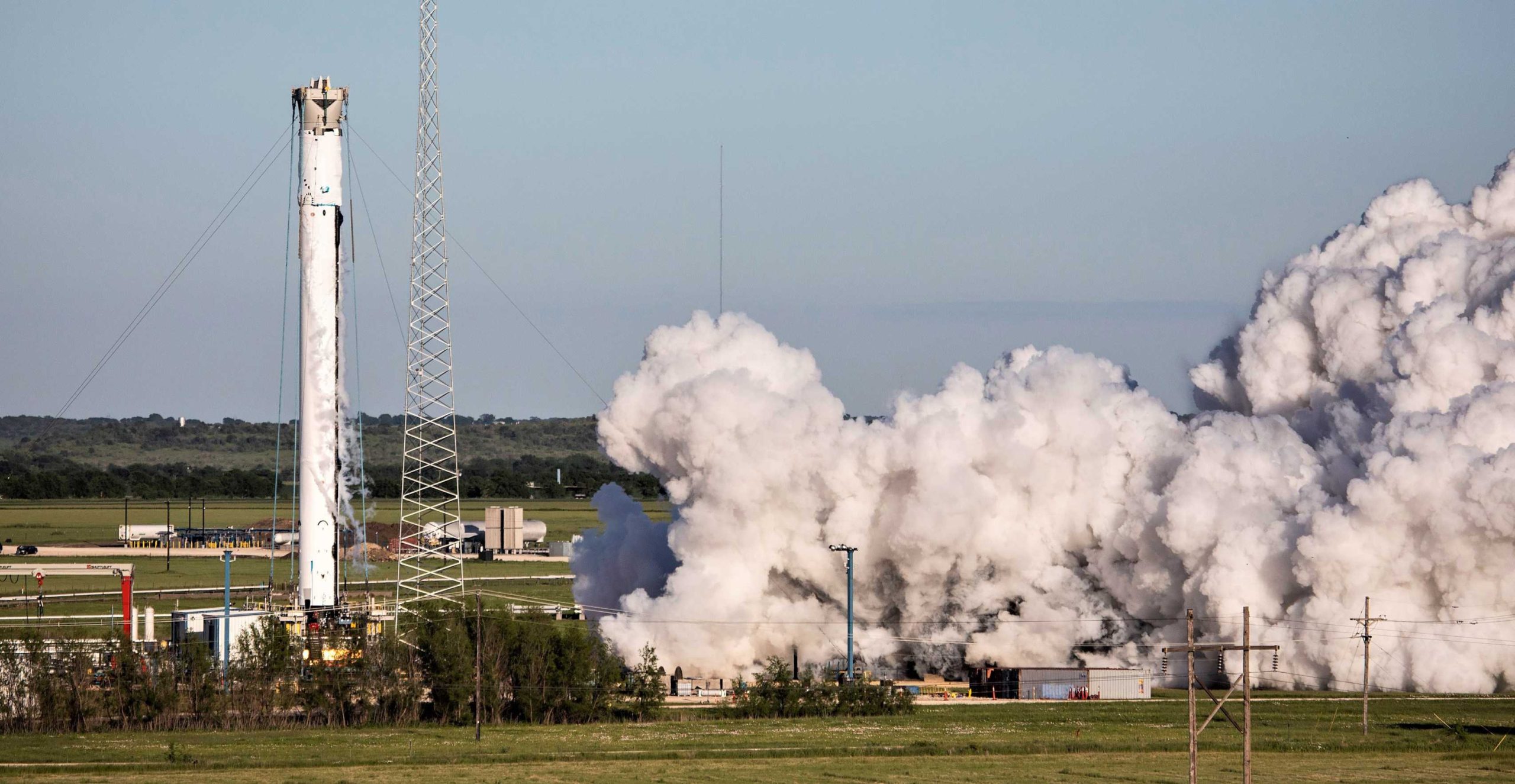
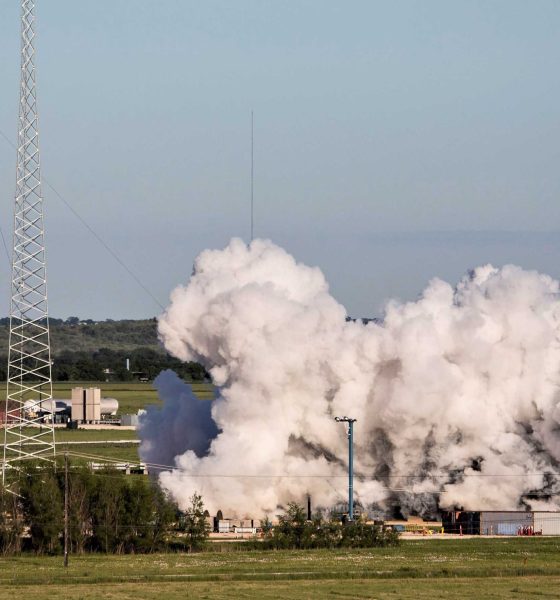
News
SpaceX’s next Falcon Heavy booster arrives in Texas for static fire
SpaceX’s fourth Falcon Heavy launch continues to inch closer, most recently celebrating what appears to be the arrival of one of three new Falcon Heavy boosters for static fire testing in Texas.
There’s a chance that the booster in question is just a regular Falcon 9 first stage but per photos from local resident Reagan, the unusual presence of a white interstage (the carbon fiber composite section containing grid fins and second stage deployment hardware) implies otherwise.
Following several months of inactivity since the first of three new Falcon Heavy side boosters – ‘disguised’ with a rejected Falcon 9 interstage – arrived at SpaceX’s McGregor, Texas test facilities, the latest booster is most likely the second of two new Falcon Heavy side boosters needed for a US military launch later this year.
After departing SpaceX’s Hawthorne, California factory sometime in late August 2020, hardware NASASpaceflight later confirmed to be the first of three new Falcon Heavy boosters went vertical at the company’s McGregor, Texas booster static fire stand around a month later. Oddly, unlike the four other Falcon Heavy side boosters SpaceX has tested over the last several years, this particular core arrived in Texas with a placeholder interstage instead of a telltale nosecone.
Why is unclear given that two previous side boosters were static fired with nosecones installed. Regardless, given that the newest booster entrant’s white interstage does not appear to have any custom center core hardware installed, it’s most likely the second of two Falcon Heavy Flight 4 side boosters.
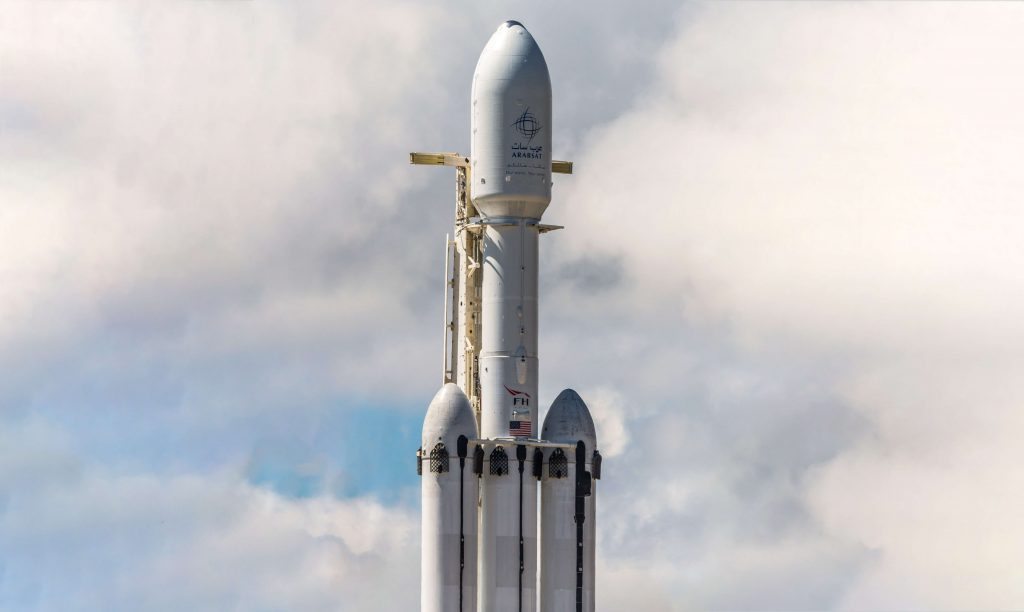
If the rocket passes those acceptance tests, that will leave another two stages – a custom center core and orbital upper stage – left to ship and test before SpaceX can say it has all hardware on hand for the triple-booster rocket’s fourth launch. Delayed from Q4 2020 to February 2021 in September 2020, that all-new Falcon Heavy’s first launch is known as AFSPC-44 or USSF-44 and will deliver an unspecified US military satellite and one or more rideshare payloads directly to geostationary orbit (GEO) – a first for SpaceX.
Unless this second side booster is days away from a brisk static fire test and a new Falcon Heavy center core and upper stage are either already at McGregor or days away from departing Hawthorne, a February 2021 launch target is all but impossible.
Not long after that tentative February 28th launch date was announced, a USAF official did offer an updated target, stating that USSF-44 was now expected to launch in “late spring” – implying (at least in the US) May or June 2021. It’s unclear what’s to blame for the six or more months of delays the mission has suffered in the last year but continued booster testing is a good sign that things are more or less back on track.

News
Tesla AI and Autopilot VP hints that Robovan will have RV conversions
Tesla’s vice president of AI and Autopilot software, Ashok Elluswamy, hinted at the linitiative in a reply to Y Combinator CEO Garry Tan.
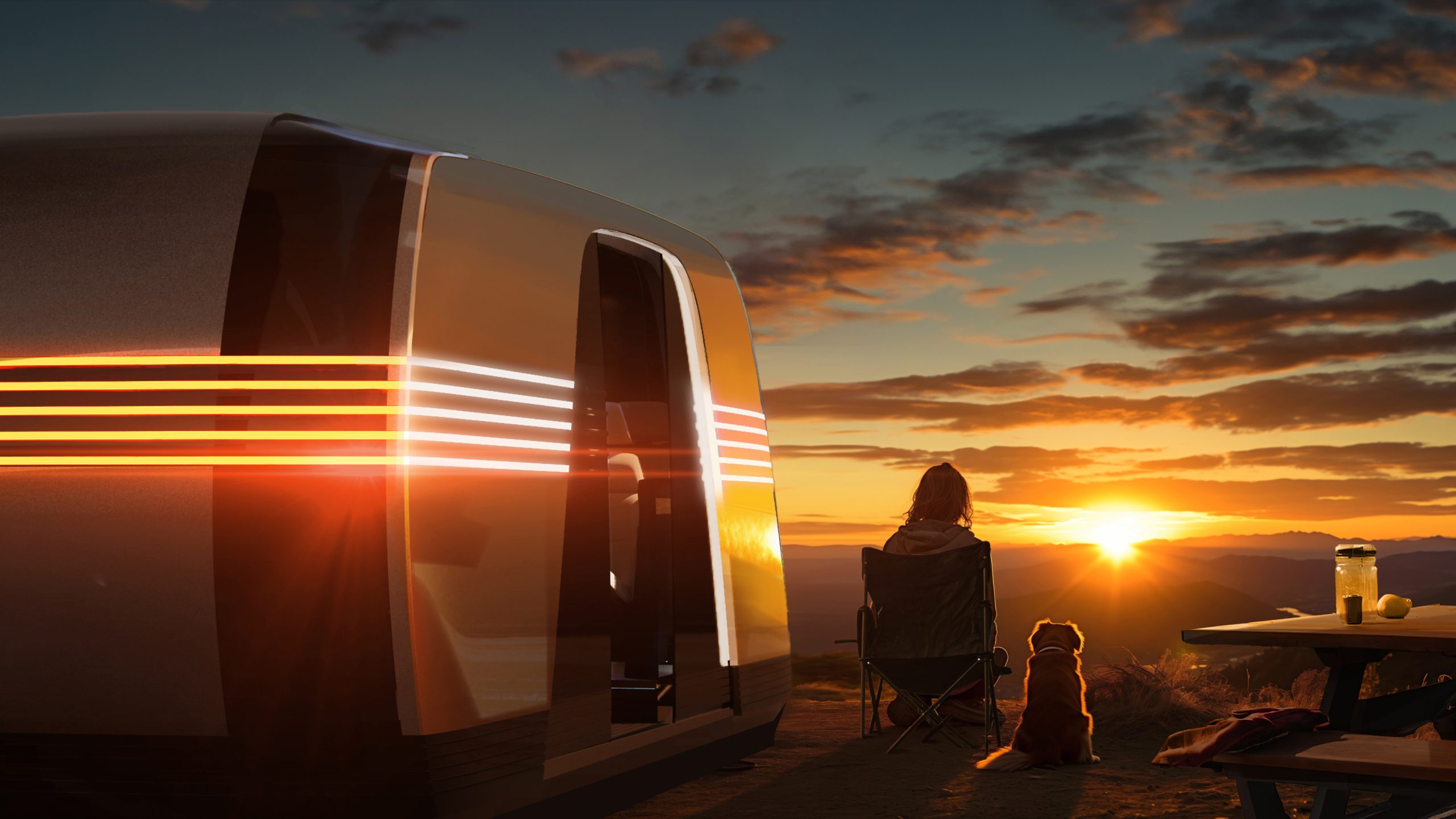
It appears that Tesla is indeed considering an RV in its future pipeline, though the vehicle that would be converted for the purpose would be quite interesting. This is, at least, as per recent comments by a Tesla executive on social media platform X.
Robovan as an RV
Tesla’s vice president of AI and Autopilot software, Ashok Elluswamy, hinted at the linitiative in a reply to Y Combinator CEO Garry Tan, who called for a startup to build RVs with Full Self-Driving capabilities. In his reply, Elluswamy simply stated “On it,” while including a photo of Tesla’s autonomous 20-seat people mover.
Tesla unveiled the Robovan in October 2024 at the “We, Robot” event. The vehicle lacks a steering wheel and features a low floor for spacious interiors. The vehicle, while eclipsed by the Cybercab in news headlines, still captured the imagination of many, as hinted at by X users posting AI-generated images of Robovan RV conversions with beds, kitchens and panoramic windows on social media platforms. One such render by Tesla enthusiast Mark Anthony reached over 300,000 views on X.
Elon Musk on the Robovan
Elon Musk addressed the Robovan’s low profile in October 2024, stating the van uses automatic load-leveling suspension that raises or lowers based on road conditions. The system maintains the futuristic look while handling uneven pavement, Musk wrote on X. The CEO also stated that the Robovan is designed to be very airy inside, which would be great for an RV.
“The view from the inside is one of extreme openness, with visibility in all directions, although it may appear otherwise from the outside. The unusually low ground clearance is achieved by having an automatic load-leveling suspension that raises or lowers, based on smooth or bumpy road conditions,” Musk stated.
Elluswamy’s response on X suggests that Tesla is considering a Robovan RV conversion, though it would be interesting to see how the company will make the vehicle capable of reaching campsites. The Robovan has a very low ground clearance, after all, and campsites tend to be in unpaved areas.
News
Tesla tinkering with Speed Profiles on FSD v14.2.1 has gone too far

Tesla recently released Full Self-Driving (FSD) v14.2.1, its latest version, but the tinkering with Speed Profiles has perhaps gone too far.
We try to keep it as real as possible with Full Self-Driving operation, and we are well aware that with the new versions, some things get better, but others get worse. It is all part of the process with FSD, and refinements are usually available within a week or so.
However, the latest v14.2.1 update has brought out some major complaints with Speed Profiles, at least on my end. It seems the adjustments have gone a tad too far, and there is a sizeable gap between Profiles that are next to one another.
Tesla FSD v14.2.1 first impressions:
✅ Smooth, stress-free highway operation
✅ Speed Profiles are refined — Hurry seems to be limited to 10 MPH over on highways. Switching from Mad Max to Hurry results in an abrupt braking pattern. Nothing of concern but do feel as if Speed…— TESLARATI (@Teslarati) November 29, 2025
The gap is so large that changing between them presents a bit of an unwelcome and drastic reduction in speed, which is perhaps a tad too fast for my liking. Additionally, Speed Profiles seem to have a set Speed Limit offset, which makes it less functional in live traffic situations.
Before I go any further, I’d like to remind everyone reading this that what I am about to write is purely my opinion; it is not right or wrong, or how everyone might feel. I am well aware that driving behaviors are widely subjective; what is acceptable to one might be unacceptable to another.
Speed Profiles are ‘Set’ to a Speed
From what I’ve experienced on v14.2.1, Tesla has chosen to go with somewhat of a preset max speed for each Speed Profile. With ‘Hurry,’ it appears to be 10 MPH over the speed limit, and it will not go even a single MPH faster than that. In a 55 MPH zone, it will only travel 65 MPH. Meanwhile, ‘Standard’ seems to be fixed at between 4-5 MPH over.
This is sort of a tough thing to have fixed, in my opinion. The speed at which the car travels should not be fixed; it should be more dependent on how traffic around it is traveling.
It almost seems as if the Speed Profile chosen should be more of a Behavior Profile. Standard should perform passes only to traffic that is slower than the traffic. If traffic is traveling at 75 MPH in a 65 MPH zone, the car should travel at 75 MPH. It should pass traffic that travels slower than this.
Hurry should be more willing to overtake cars, travel more than 10 MPH over the limit, and act as if someone is in a hurry to get somewhere, hence the name. Setting strict limits on how fast it will travel seems to be a real damper on its capabilities. It did much better in previous versions.
Some Speed Profiles are Too Distant from Others
This is specifically about Hurry and Mad Max, which are neighbors in the Speed Profiles menu. Hurry will only go 10 MPH over the limit, but Mad Max will travel similarly to traffic around it. I’ve seen some people say Mad Max is too slow, but I have not had that opinion when using it.
In a 55 MPH zone during Black Friday and Small Business Saturday, it is not unusual for traffic around me to travel in the low to mid-80s. Mad Max was very suitable for some traffic situations yesterday, especially as cars were traveling very fast. However, sometimes it required me to “gear down” into Hurry, especially as, at times, it would try to pass slower traffic in the right lane, a move I’m not super fond of.
We had some readers also mention this to us:
The abrupt speed reduction when switching to a slower speed profile is definitely an issue that should be improved upon.
— David Klem (@daklem) November 29, 2025
After switching from Mad Max to Hurry, there is a very abrupt drop in speed. It is not violent by any means, but it does shift your body forward, and it seems as if it is a tad drastic and could be refined further.
News
Tesla’s most affordable car is coming to the Netherlands
The trim is expected to launch at €36,990, making it the most affordable Model 3 the Dutch market has seen in years.
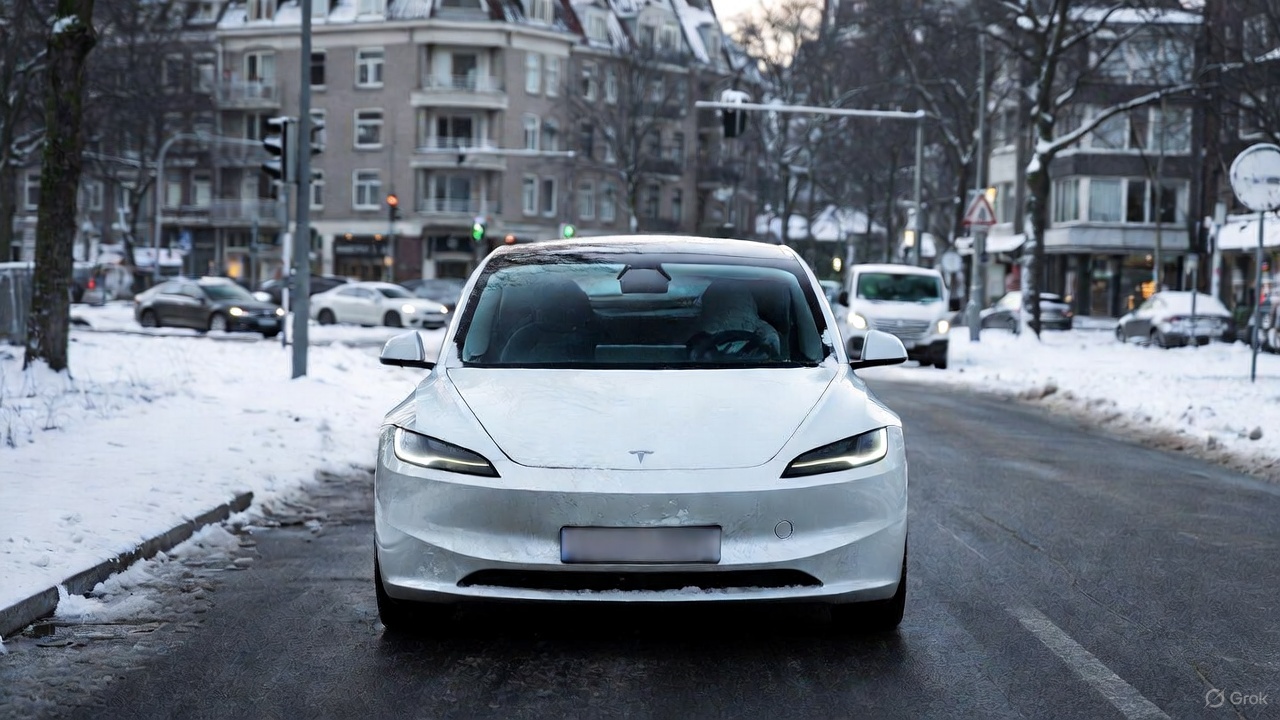
Tesla is preparing to introduce the Model 3 Standard to the Netherlands this December, as per information obtained by AutoWeek. The trim is expected to launch at €36,990, making it the most affordable Model 3 the Dutch market has seen in years.
While Tesla has not formally confirmed the vehicle’s arrival, pricing reportedly comes from a reliable source, the publication noted.
Model 3 Standard lands in NL
The U.S. version of the Model 3 Standard provides a clear preview of what Dutch buyers can expect, such as a no-frills configuration that maintains the recognizable Model 3 look without stripping the car down to a bare interior. The panoramic glass roof is still there, the exterior design is unchanged, and Tesla’s central touchscreen-driven cabin layout stays intact.
Cost reductions come from targeted equipment cuts. The American variant uses fewer speakers, lacks ventilated front seats and heated rear seats, and swaps premium materials for cloth and textile-heavy surfaces. Performance is modest compared with the Premium models, with a 0–100 km/h sprint of about six seconds and an estimated WLTP range near 550 kilometers.
Despite the smaller battery and simpler suspension, the Standard maintains the long-distance capability drivers have come to expect in a Tesla.
Pricing strategy aligns with Dutch EV demand and taxation shifts
At €36,990, the Model 3 Standard fits neatly into Tesla’s ongoing lineup reshuffle. The current Model 3 RWD has crept toward €42,000, creating space for a more competitive entry-level option, and positioning the new Model 3 Standard comfortably below the €39,990 Model Y Standard.
The timing aligns with rising Dutch demand for affordable EVs as subsidies like SEPP fade and tax advantages for electric cars continue to wind down, EVUpdate noted. Buyers seeking a no-frills EV with solid range are then likely to see the new trim as a compelling alternative.
With the U.S. variant long established and the Model Y Standard already available in the Netherlands, the appearance of an entry-level Model 3 in the Dutch configurator seems like a logical next step.









